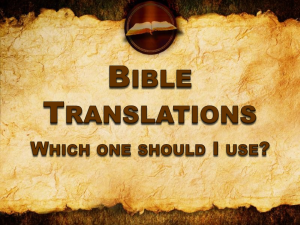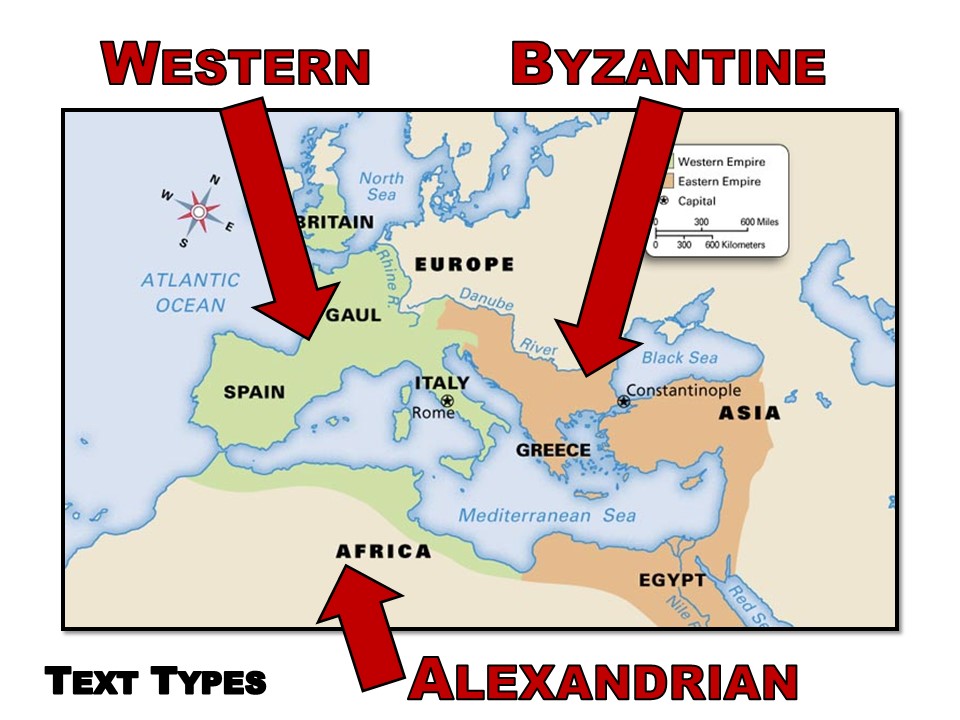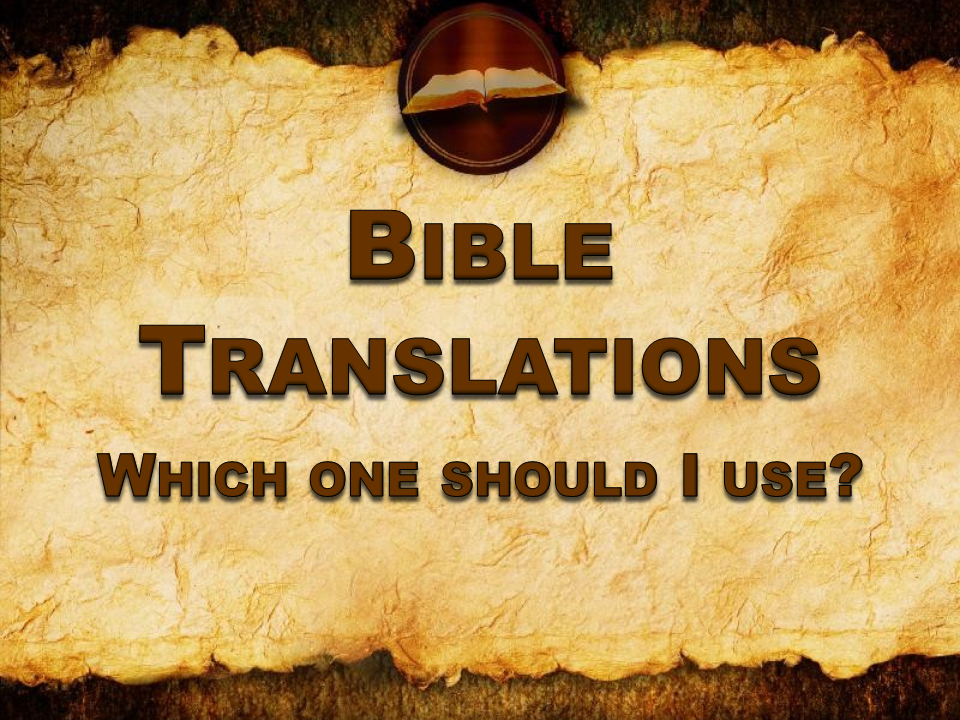Click here to begin in Section 1: History of the Bible

It may not surprise you that the Bible was not written in English. The Old Testament was written mostly in Hebrew, although some parts were penned in Aramaic. The New Testament was originally written in Greek. It also may not surprise you that we no longer have the original manuscripts (known as autographs). It is my opinion that God did not allow these to be retained because Christians would begin to worship them as holy relics.
In the absence of the original manuscripts, biblical scholars have burdened themselves with the task of determining their actual contents. This endeavor is much more difficult than it may seem.
The original writers of the Bible did not have access to paper, computers, and word processing software. Many of the writers used papyrus, which was a product of the bark of the papyrus, or byblus reed. The bark was cut in strips, dried, and glued together horizontally and vertically, and then rolled up like a scroll. Eventually parchment, which was made from dried animal skins, came into popular use. Writings on both papyrus and parchment were later put into a form similar to the modern book. These were called codexes.
These primitive writing materials, of course, were not permanent. If they were to be preserved, copies had to be made. In the absence of electronic copiers, the copying had to be done by hand.
For each book in the Bible, there was one original manuscript. Because that manuscript could only be in one place at one time, a copy would be made and passed along to another location. Soon another copy would be made and sent somewhere else. Eventually copies were made of the copies. Any inadvertent additions, changes, or deletions that were made within a certain locality were passed along to the others in that area, creating a “text-type” of similar documents.
Unfortunately, the human error that crept into the copying process of these texts often went undetected. Similar letters could be confused and some words or phrases left out. When the copying was done through dictation, some words could be audibly misunderstood. In some places marginal notes could be inadvertently added into the text by an innocent scribe. [i] These errors were then unknowingly passed along by later copyists. In many cases, these occasions explain the differences between English Bible versions that were translated from different texts.
Old Testament Text
Although it seems that most of the discussion about text types centers around the New Testament, the Old Testament text is worthy of discussion. The fact that persecution of the Jews caused them to be spread around the known world resulted in various text-types of the Scriptures. In the beginning of the first century AD, Jewish scholars began to see the importance of standardizing the text of Scripture. In the fifth to tenth centuries, a group of Jews known as the Masoretes meticulously compiled and copied the Scriptures. If you have ever taken a beginning class in Hebrew, you know about the Masoretes. As Hebrew is a language of only consonants, the Masoretes added a system of vowel pointings to describe how the words were pronounced. In that way copies of the Scripture would have the same number of letters as the original, yet the pronunciation would be preserved for future generations.
The Masoretes were charged with evaluating the available texts in an effort to determine the original text as much as possible. Their work did not result in one official standard manuscript, but rather a family of manuscripts, known as the Masoretic text. Variations can be found between Masoretic manuscripts just as would be expected within any general text type.[ii]
Around the tenth century AD, the family of ben Asher became the leading family of Masoretes. The texts they produced soon became the recognized Hebrew Scriptures[iii] and are collectively known as the ben Asher text.
In 1516, Daniel Bomberg added his contribution to the mix of Hebrew Scriptures in the Masoretic tradition, publishing the First Rabbinic Bible. In 1524, the Second Rabbinic Bible was published by Jacob ben-Chayyim. It is this text from which the KJV is largely (though not exclusively[iv]) translated. Almost four hundred years later, Rudolph Kittel published two editions (1906, 1912) of the Hebrew Scriptures, using the ben Chayyim text. These are called the Biblia Hebraica (BH or BHK). In 1937, a third edition of the Biblia Hebraica was published by Paul Kahle, using the text of the Leningrad Codex (the oldest ben Asher text, dated AD 1008). In 1977 the first edition of the Biblia Hebraica Stuttgartensia (BHS) was published, which was a revision of the third edition of the Biblica Hebraica. The fourth revision of the BHS was published in 1997.
Here is a graph of the Masoretic texts used by popular Bible versions:
New Testament Text
There are three major divisions of Greek text types for the New Testament Scriptures—Alexandrian, Western, and Byzantine. To understand the differences between them, we have to consider a bit of history.
In 395 A.D., Emperor Diocletian divided the Roman Empire in two sections, east and west. Latin became the most widely used language of the western empire, so naturally the folks there copied and disseminated writings (including the Scriptures) in Latin. Therefore, most of the Western text types are in Latin have a lesser impact on our discussion than do the text types from the other geographical regions.
The eastern section of the Roman Empire became known as the Byzantine Empire. Greek was the official language of the Byzantine Empire, so the Byzantine monks tended to copy Greek manuscripts of the New Testament, leading to the Byzantine text type. Most of the ancient manuscripts we have today are Byzantine.
The third group is the Alexandrian text type, named after Alexandria, Egypt. Although these manuscripts are fewer in number than the Byzantine manuscripts, they are thought to be older. Their longevity may be a result of the dry Egyptian climate, which allows for a longer life for papyrus documents.[v] The most notable documents of this text type are the Codex Vaticanus (so named because it was found in the Vatican library) and the Codex Sinaiticus (found on Mount Sinai). Both are believed to date from the early fourth century AD.
Codex Sinaiticus has quite an interesting story. It was found by Constantine von Tischendorf in 1844 as he was engaged in a mission to locate ancient Scripture texts.[vi] His passion to clear the biblical text of all the corruptions that had been handed down through the centuries brought him to the monastery of St. Catherine at Mount Sinai. While he was there, he happened to find some old copies of the Septuagint (Greek translation of the Old Testament) in a basket waiting to be burned. Noting their importance, he was allowed to take forty-three of the leaves. His uncontainable excitement alerted the monks to the importance of the find. Consequently, he was subsequently barred from taking more, even when he returned in 1853. In 1859, however, he revisited the monastery with the blessing of the Emperor of Russia, which bought him a high degree of respect. Still, he was unable to locate the full document and feared it had been destroyed.
The day before Tinschendorf planned to leave the monastery, a steward invited him into his quarters. Because Tischendorf had previously published an edition of the Septuagint, the steward boasted that he had read a copy of the Septuagint himself. As proof, he took his copy of the Septuagint off a shelf and when Tischendorf saw it, he knew that this was indeed the document for which he had been searching. To his delight, not only was most of the Old Testament (Septuagint) intact, but so was all of the New Testament. It is this text that became known as Codex Sinaiticus.
One of the arguments against the Sinai text is that it was originally located in a trash bin. The thought is that if the manuscript was revered as an authentic and reliable copy of the New Testament, it would never have been relegated to the burn pile. However, upon further review, Tischendorf’s excitement tipped off the monks as to the value of the document. If they truly had reason to believe it was worthless, they would have told him so and would not have made it so difficult to procure in the future. Apparently they just did not know the value of the document.
The following map may help explain the location of different text types. The areas shaded in green and brown are the east and west divisions of the Roman Empire. 
Textual Criticism
Modern textual criticism is the art of studying Byzantine and Alexandrian texts in an effort to determine as much as possible the exact contents of the original manuscripts. In doing so, scholars must consider a very important question. Should greater importance be attributed to an older manuscript or does majority rule? Those who believe in majority rule will favor the Byzantine text type, simply because there are more Byzantine manuscripts available. Those who prefer older manuscripts will favor the Alexandrian text type. Who is right? Three approaches have been proposed to answer this question, and the approach chosen will influence the final translation.
Majority Text Approach
One proposed answer is what is officially called the “Majority text approach.” A majority text is compiled by accumulating all the available texts, effectively dumping them into one bucket, and giving each a vote when the wording varies. Obviously, a majority text will favor the Byzantine text simply because there are many more texts of this type available. A downfall of this approach is that any widely disseminated errors will be present in the finished work. No major Bible versions have been translated from a majority text.
The Byzantine Text Approach (Textus Receptus)
Those who hold to the preeminence of the King James Version often decry the above methods of textual criticism in favor of the Textus Receptus (TR). Therefore, it is fitting that we take a look at this important collection of manuscripts.
In 1515 AD, a Dutch scholar named Desiderius Erasmus, in conjunction with a printer named Johann Froben, gathered a few Greek manuscripts of the Byzantine text type, hoping to combine them into one official text. These manuscripts he used were dated from the twelfth to fourteenth centuries.[vii] No single manuscript contained the entire New Testament, and even when combined, the final six verses of Revelation were missing. Erasmus solved this problem by back-translating from the Latin Vulgate into Greek, a process he also used for other places where the Greek was unintelligible or unable to be distinguished from commentary that readers had written on the pages.[viii] When his compilation was printed in 1516, it was found to be full of errors, so in 1519 a new edition was sent to the press. A third edition, printed in 1522, is famous because it included I John 5:7 for the first time. Apparently there was an outcry when his earlier editions did not contain this verse (which appears in the Latin Vulgate), so he promised that if someone could produce one Greek text with this verse, he would add it in his next edition. A sixteenth century manuscript containing the verse was produced, so true to his word, Erasmus included it in the 1522 edition. However, he also included a footnote indicating his opinion that it should not appear in the text.[ix] Two more editions were later published by Erasmus, one in 1527, and a final one in 1535.
The French printer Robert Estienne (better known as Stephanus, the Latin rendition of his name), published editions of the Greek New Testament in 1546, 1549, 1550 (which was based on Erasmus’ final two editions), and 1551. His final edition (1551) introduced for the first time the New Testament verse divisions that we find in our modern Bibles[x] (Steven Langton, around 1227, divided the chapters, and the OT verses were created in 1448).[xi]
Between 1564 and 1604, Theodore de Beza published nine editions of the Greek New Testament. It was his 1588/89 edition that was used heavily by the translators of the King James Version.
Publishers Bonaventure and Abraham Elzevir soon joined the fray, producing their first Greek New Testament in 1624, and a second in 1633. In the preface to the 1633 edition the publishers printed these words: “So [the reader] has the text which all now receive.” As a result, this whole line of revisions became known as the “received text,” or as it came across in Latin, “Textus Receptus” or “TR.”
It is crucial to note that there is no one official “Textus Receptus.” Although the Trinitarian Bible Society has published an edition of the TR, it is an eclectic text that combines readings from different sources within the TR tradition.[xii]
The Critical/Eclectic Text Approach
Because the Textus Receptus was widely available in printed form, it was viewed for a long time as the official text of the New Testament. Eventually, however, scholars began to compare it with the many other New Testament manuscripts that were being discovered, leading to what can be called the “critical” or “eclectic” approach. Rather than attributing equal weight to each manuscript, scholars distribute importance based on factors such as the age of the text, its geographical location, and known theological bias of the scribes who copied it. The critical approach places a great deal of importance on the Alexandrian texts Codex Vaticanus and Codex Sinaiticus, because of their age.
In the nineteenth century, Greek New Testaments began to be published that were based on this approach. The most famous of these may be that which was published in 1881-1882 by Wescott and Hort.[xiii] Their edition became the basis for the English Revised Version of 1881, which was adapted for use in America in 1901 as the American Standard Version.
It is also important to note that in 1898, Eberhard Nestle published his first work, known in Latin as the Novum Testamentum Graece, a Greek edition of the New Testament that was based on his comparison of the editions of Wescott/Hort, Tischendorf, and Weymouth.[xiv] In 1955, the American Bible Society formed a committee of scholars who published a Greek New Testament designed for Bible translators (complete with information on textual variants). This was known as the United Bible Societies’ Greek New Testament (GNT). In 1963, Kurt Aland expanded on the twenty-four editions of the GNT, and this twenty-fifth edition became known as the Nestle-Aland (NA) text.[xv]
One notable factor about editions of the NA text is that the compilers did not rely heavily on the single texts of the Sinaiticus and Vaticanus texts. They preferred instead to look at all the text types in an effort to determine how the differences came to be.[xvi]
If this information is new to you, you might find yourself a little confused. That is understandable, because there is an inordinate amount of history on this subject. You might also find yourself questioning how we can know that we actually have the Word of God. The answer is quite simple. While some differences between texts include verses or even chapters, most deal only with minor differences, such as spelling.
This may also lead to you question why God would allow the history of His book to be so “messy.” Why would He deliver His book through human hands, allowing it to be disseminated in such a way that introduced errors into the copied text? James White offers an interesting answer to this question:
By having the text of the New Testament in particular “explode” across the known world, ending up in the far-flug corners of the Roman Empire in a relatively short period of time, God protected that text from the one thing that we could never detect: the wholesale change of doctrine or theology by one particular man or group who had full control over the text at any one point in history. You see, because the New Testament books were written at various times, and were quickly copied and distributed as soon as they were written, there was never a time when any one man, or any group of men, could gather up all the manuscripts and make extensive changes in the text itself, such as cutting out the deity of Christ, or inserting some foreign concept or doctrine.[xvii]
In effect, the existence of a great host of biblical texts minimizes the possibility for any one text into which a heretic could inject a major change of doctrine. Therefore, in the “messiness” of textual criticism is found confirmation of the purity and preservation of God’s Word.
Click here to see the next section: Methods of Translation
Click here to download all four sections in PDF
Section 1: History of the Bible
Section 2: Underlying Texts
Section 3: Methods of Translation
Section 4: How to Choose a Translation
[i] Metzger, Bruce, The Text of the New Testament: Its Transmission, Corruption, and Restoration, 3rd edition (New York: Oxford University Press, 1992), 186-206.
[ii] Roy E. Beacham and Kevin T. Bauder, ed. One Bible Only? Examining Exclusive Claims for the King James Bible (Grand Rapids: Kregel Publications, 2001), 63.
[iii] Preface to New King James Version (Nashville, Thomas Nelson, 1982). Can be viewed at http://www.christianbook.com/Christian/Books/cms_content?page=186191&sp=57319
[iv] Beacham, 67.
[v] D. A. Carson, and Douglas J. Moo, An Introduction to the New Testament, 2nd ed. (Grand Rapids: Zondervan, 2005), 25.
[vi] Constantine Von Tischendorf, When Were Our Gospels Written? Translated by the Religious Tract Society [book online] (New York: American Tract Society). Christian Classics Ethereal Library. Constantin von Tischendorf. http://www.ccel.org/ccel/tischendorf/gospels.html.
[vii] Metzger, 99.
[viii] Ibid., 88-100.
[ix] Ibid., 101.
[x] Norman L. Geisler and William E Nix, A General Introduction to the Bible (Chicago: Moody Press, 1968, reprint 1980), 385.
[xi] http://www.compellingtruth.org/divided-Bible-chapters-verses.html
[xii] Beacham, 86.
[xiii] Harold J. Greenlee, The Text of the new Testament: From Manuscript to Modern Edition (Peabody, MA: Hendrickson Publishers), 54.
[xiv] Ibid., 55.
[xv] Ibid., 56.
[xvi] Ibid.
[xvii] James R. White, The King James Only Controversy: Can you Trust the Modern Translations? (Minneapolis, MN: Bethany House Publishers, 1995), 47-48.



